
Indoor Air Quality Specialists

The air inside a typical home is up to 5 times dirtier than the air outside! The same insulation and seals that keep warm and cold air inside your home, also keep in chemicals and particulates. These materials can emanate from a number of a household products and cleaners found throughout the home.
Everyone has a physical tolerance level for the airborne chemicals and particulates. Some people have a higher tolerance than others for dirty air, but it affects everyone. Children whose respiratory system is still developing are at greater risk of asthma or allergies if they are exposed to many airborne contaminants. Increased levels of contaminants in the air can even affect the well-being of a fully developed healthy adults. The higher the level of contaminants in the air, the quicker a person can their tolerance level. Then the contaminants could start to damage their respiratory system and their general health.
The key is to reduce the amount of contaminants taken into the body. This can be done by reducing the number of particles in the air. HEPA filtration is standard developed by the U.S Atomic Energy Commission and is used to remove microscopic particles from the air. HEPA filtration in the home will reduce the number of contaminants in the home. The higher airflow of the HEPA filtration system, the quicker the levels will drop.
Significant reduction of contaminants in the home can help the body recover from constant exposure to contaminants outside the home. We like to say this reduction in the stress to our respiratory system can be compared to a good night’s sleep for a tired athlete.
Ultra-fine particles are called “respirable” particles because they are inhaled in the lungs and are small enough to bypass the human body`s defense mechanisms. According to the American Lung Association, “While larger particles (greater than 10 microns in diameter) get caught in the nose and throat, and are cleared naturally by coughing or swallowing, particles smaller than 10 microns in diameter are easily inhaled into the lungs. Of these, the smallest particles are most likely, to reach the alveoli, where they can remain embedded for years, or in the case of soluble particles, be absorbed into the bloodstream.”
If you can answer yes to two or more of the following questions, you may want to take steps to improve the IAQ of your home.
- Does anyone in your family suffer from allergies, asthma or other respiratory problems?
- Do they notice that their symptoms (headaches, fatigue, nasal congestion, sore throat, etc..) are worse at night or in the morning?
- Does any family member have immune system problems or illness?
- Do you have an infant child or elderly family members?
- Is there a smoker in the house?
- Are there any pets?
- Do you notice a stale or musty odor when the furnace or air conditioner runs
- Do you notice dust on the furniture shortly after cleaning
- Is your home new?
- Is your home more than 10 years old?
- Does dirt or dust accumulate on your supply or return air grills?
Particulate Removal
Common indoor air particulates include dirt, dust, fibers tobacco smoker particles and fireplace or wood stove soot. Airborne particles can from .01 microns in size to 100 microns in size however, studies have shown that more than 99% of the particles suspended in the air are ultra-fine, one micron ( 1/1,000,000 or a meter ) or smaller. To put this size in perspective, the width of a human hair is about 50 to 200 microns. Most of us cannot see particles smaller than 10 microns. These particles can remain airborne for very long periods of time, unlike larger particles that ten to settle on surfaces.
Source Removal
Air care Negative source removal: IAQ experts now estimate that more than 70 % of all indoor air quality involve the operation and/ or maintenance of HVAC systems. Like any other part of a home or building, dirt, dust and other particulates can accumulate on system components and in ductwork. Studies have shown that even a thin coating of dirt and dust on critical HVAC components can significantly reduce energy efficiency.
General Air HEPA Filtration
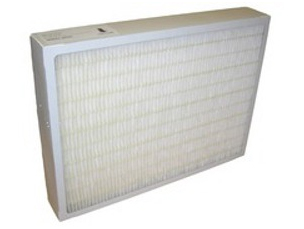
Generally speaking, the more air changers per hour (ACH) you can provide the more effective a HEPA filter can be. 1 ACH provides excellent air cleaning results (higher is recommended for the people with sensitivities). Remember: more HEPA is better than less, but some HEPA is better than nothing at all.
Humidifiers
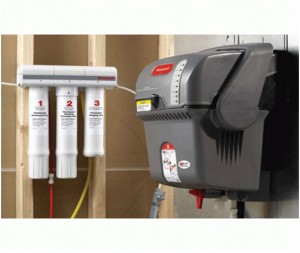
Steam Humidifier: Many humidifiers work only when they heating system is actively running. The Honeywell Whole-House Steam humidification works effectively with your heating system but lets you control the humidity independently, so you can add needed moisture to your home without turning up the heat. Honeywell Steam Humidifier features a thermal switch that turns on the steam fan as needed. You will be able to set the humidity where you like it and enjoy consistent, reliable comfort.
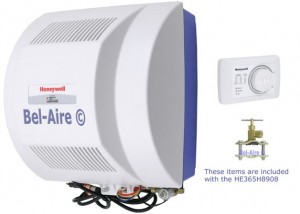
BY-PASS Humidifiers: Maintain your home`s most comfortable level automatically with a Honeywell Bypass flow- through Humidification. Proper humidity provides a more comfortable living environment at a lower temperature, so you can turn down your thermostat for energy saving.
Bio-Agent Reduction
Germicidal Ultraviolet Lights
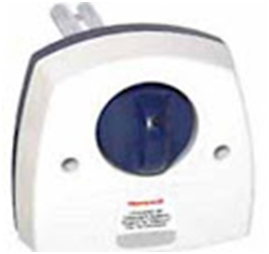
The Honeywell UV air treatment system can kill up to 87 % of certain airborne bacteria* in the air passing through your heating/cooling system, reducing the presence of these harmful agents in the air you family breathes.
*Test Performed shows a single-pass kill rate of serratia marcescens batercia in a clean metal 12*25 duct airflow of 2000 cfm using new lamps.
Whole House filtration packages: Includes source removal, UV Light, and choice of air filter. Drop-in Media Filter, Source removal, and UV light.
Zoning Systems
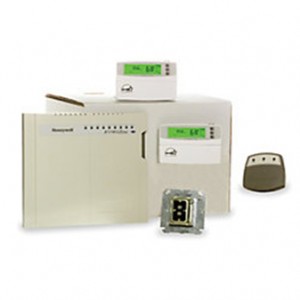
Comfort Zoning:
Control heating and cooling comfort where you want it, and when you wants it. With a Zoning System you won’t heat empty rooms or over-cool one area in order to be comfortable in another. Zoning makes it possible for everyone to be comfortable.
You do not have to buy a new heating and cooling system for every room. A Zoning system uses dampers in your ductwork that open and close as needed bases on each zone`s thermostat settings. When a zone is at the selected temperature, and doesn’t need to be heated or cooled, the dampers close to save energy and maximize comfort elsewhere. Think of it as controlling the heating and cooling the same way you control your lights – a thermostat controls each zone to the temperature you choose.
